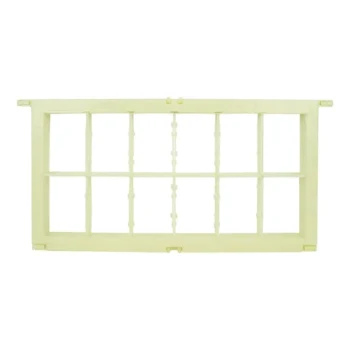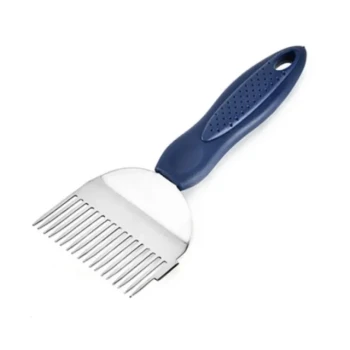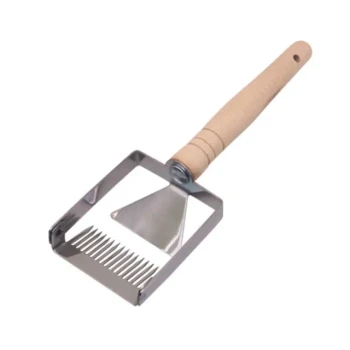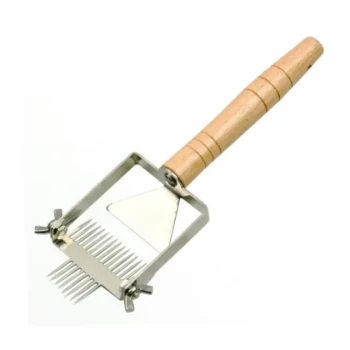A Flow Hive has a significantly higher upfront purchase price than a conventional Langstroth beehive. This initial sticker shock is the most prominent difference, but it doesn't represent the total cost of ownership. The Flow Hive's price includes a built-in honey extraction system, whereas the lower cost of a conventional hive is only the first of several required purchases.
The core financial difference is not in the hives themselves, but in the method of honey extraction. You are choosing between a higher upfront cost for an all-in-one system (Flow Hive) versus a lower initial cost with significant future expenses for separate extraction equipment and labor (conventional hive).
The Two Philosophies of Cost
When comparing these two systems, you are looking at two different approaches to beekeeping investment: an integrated system versus a component-based system.
The Flow Hive: An All-in-One System
The price of a Flow Hive bundles the hive structure with its patented honey extraction technology. The specialized Flow Frames are the most expensive component, as they contain the complex mechanism that allows honey to be harvested directly from the hive.
This model front-loads the majority of your equipment costs into a single purchase.
The Conventional Hive: An À La Carte Approach
A basic conventional beehive, such as a Langstroth model, is comparatively inexpensive to purchase. It consists of simple wooden boxes, lids, and a base.
However, this initial price is deceptive. It does not include any of the tools required to actually harvest honey from the frames.
The Hidden Costs of Conventional Honey Extraction
The true cost comparison emerges when you account for the process of harvesting honey from a traditional hive. This requires a significant investment in both equipment and time.
Essential Extraction Equipment
To get honey from a conventional frame into a jar, you must purchase a separate set of tools. This often includes:
- An extractor, which is a centrifuge that spins honey out of the frames (this is the most expensive piece).
- An uncapping knife or fork to remove the wax cappings from the honeycomb.
- Filters and strainers to remove wax and debris.
- Holding tanks or food-grade buckets for collection.
The cost of this equipment can easily meet or exceed the initial price difference between the two hive types.
The Cost of Labor and Time
Beyond the equipment, conventional harvesting is a multi-step, labor-intensive process. It involves removing frames, transporting them to a dedicated space, cutting the cappings, loading the extractor, spinning the honey, and cleaning up a very sticky mess.
For hobbyist beekeepers, this time and effort represents a significant, non-monetary cost.
Understanding the Trade-offs
Choosing a hive is not just a financial decision; it involves practical and philosophical considerations.
Financial Reality vs. Scale
For a single hive, the Flow Hive's convenience can justify its price by saving you from buying a costly extractor you'll only use once a year.
However, for a beekeeper managing many hives, the cost of one good extractor can be spread across the entire operation. In this scenario, the high per-unit cost of Flow Hives becomes less economical.
Material Differences
The Flow Hive's honey-harvesting frames are made of BPA-free plastic. While the bees still build their brood comb on natural wax in the lower box, the honey is stored in these plastic cells.
Many conventional beekeepers also use plastic foundations, but a traditional hive gives you the option to use all-wax foundation or go foundationless, which some keepers prefer for a more "natural" approach.
Making the Right Choice for Your Goal
The "best" hive depends entirely on your priorities as a beekeeper.
- If your primary focus is the lowest possible initial startup cost: A conventional Langstroth hive is the undeniable entry point, allowing you to defer extraction costs.
- If your primary focus is simplicity, convenience, and minimal labor: The Flow Hive's all-in-one design justifies its higher price by eliminating the need for separate, expensive equipment and a complex harvesting process.
- If your primary focus is scalability for a large apiary: The conventional model, with a single set of extraction equipment serving many hives, is the more financially sound long-term investment.
Ultimately, the most cost-effective choice is the one that best aligns with your personal goals, available time, and long-term vision for beekeeping.
Summary Table:
| Aspect | Flow Hive | Conventional Hive |
|---|---|---|
| Initial Hive Cost | High (all-in-one) | Low (hive only) |
| Extraction Equipment | Included (Flow Frames) | Required Separately ($$$) |
| Harvesting Labor | Minimal (on-site tap) | High (multi-step process) |
| Best For | Convenience & Simplicity | Scalability & Low Startup Cost |
Ready to choose the right hive for your apiary?
At HONESTBEE, we supply commercial apiaries and beekeeping equipment distributors with the durable, scalable solutions they need to succeed. Whether you're building a large-scale operation with conventional Langstroth hives or evaluating the latest technologies, our wholesale-focused expertise ensures you get the best value.
Let's discuss your beekeeping goals and build a cost-effective strategy for your business.
Contact our expert team today to explore our full range of beekeeping supplies and equipment.
Related Products
- Automatic Honey Flow Beehive 4 Frame Mini Hive for Beekeeping
- Stainless Steel Triangle Support Honey Strainer and Filters
- Professional Sectional Comb Honey Frame with 250g Cassette System for Beekeeping
- Wholesales Dadant Size Wooden Bee Hives for Beekeeping
- HONESTBEE 4 Frame Manual Self Reversing Honey Extractor for Beekeeping
People Also Ask
- What safety features does the Auto Flow Hive offer? Harvest Honey with Minimal Risk of Stings
- Why is the Auto Flow Hive better for the bees? Minimizing Stress with Non-Intrusive Harvesting
- What are the efficiency benefits of using a Flow Hive for honey harvesting? Unlock a Gentle, On-Demand System
- How does the Flow Hive address the issue of honey crystallization? Prevent and Manage Crystallization
- Why do new beekeepers often adopt the Flow Hive? Simplify Honey Harvesting for Beginners



















